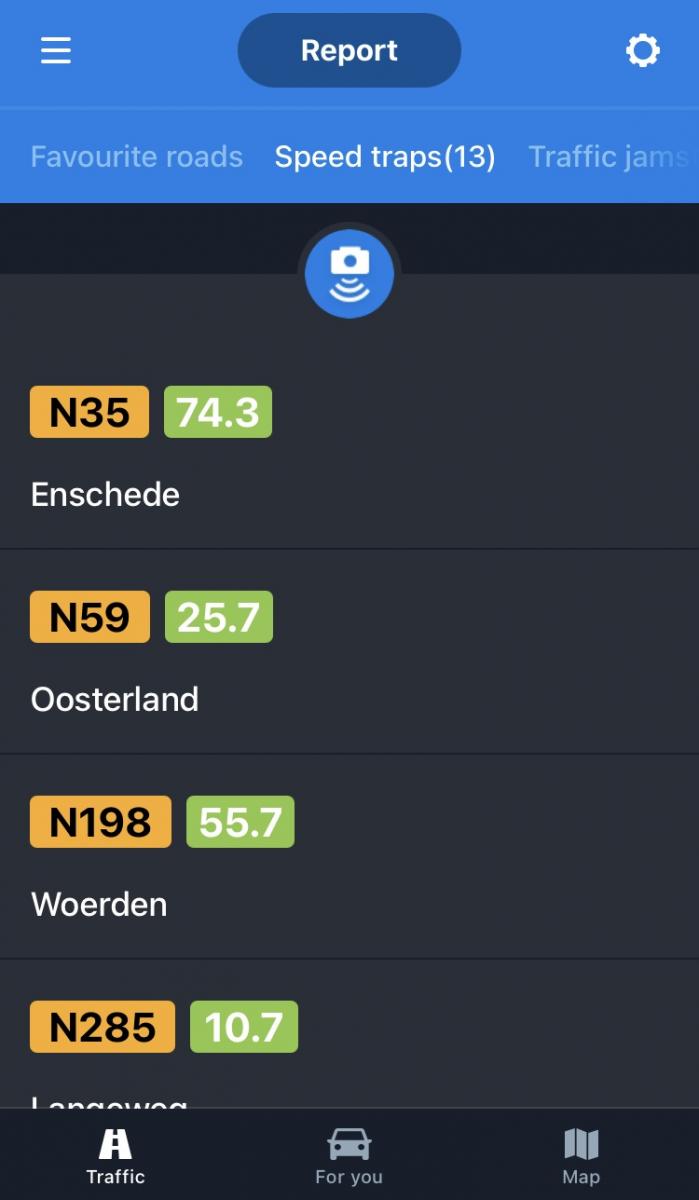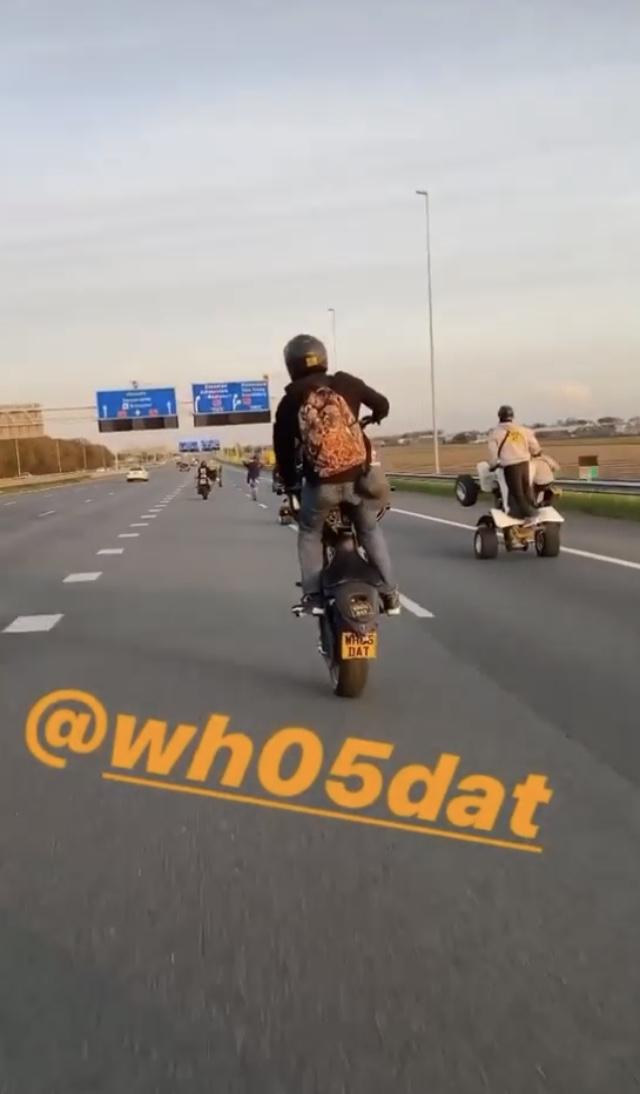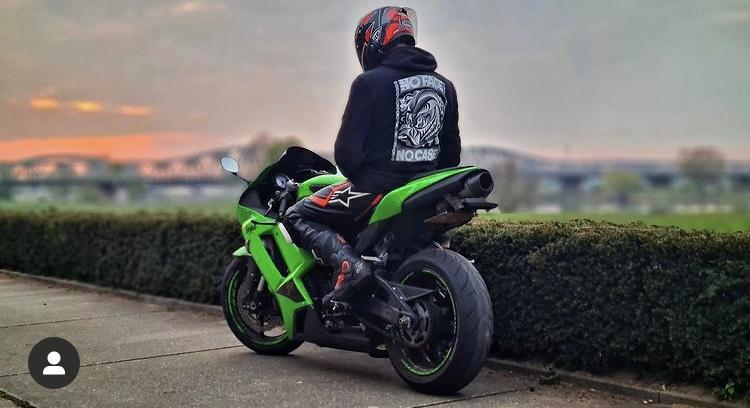
Motorcyclists and police surveillance: driving daringly without getting caught
The life of motorcyclists can be really easy. If one never drives faster than the speed limit and keeps both wheels on the ground, there is not much to worry about. However, this driving style is not for everyone. Some seek the thrill of going to extreme speeds and doing tricks like wheelies and burn-outs. Unfortunately for them, it is prohibited by Dutch law to do these things on public roads.
There are many ways in which motorcyclists are being surveilled, all of which enable punishment of some sort if the law is broken. As a result, motorcyclists have to be creative to find ways to avoid this surveillance. This article will focus on police surveillance of motorcyclists, in the context of both public roads, and social media. I will analyze online data as well as data that I have collected when I joined a Dutch motor group on several occasions in the past half-year.
Motorcyclists outsmarting surveillance
One of the most important things to note is that most public roads are surveillant landscapes (Jones, 2017). In surveillant landscapes, someone or something is able to watch the activities of the visitors and give meaning to these activities. The public road could even be described as a panopticon as mentioned in the writing of Jeremy Bentham and Michel Foucault: through traffic cameras, police checks, patrols, and dashcams, a motorcyclist never knows when their actions are being watched by the police.
The fact that there is always a possibility of being watched should be an invitation for better driving behavior. However, this is not necessary, because a lot of the aforementioned surveillance is indexical: it is clear where it takes place, who and what is being surveilled, and what the intention of the surveiller is (Jones, 2017). To take traffic cameras as an example: there is an app called Flitsmeister, in which all traffic cameras are registered. It is known where they are, what they measure (e.g. driving speed or stopping for a red light), and in which direction they are pointed. The app even shows a notification when the user is driving past a traffic camera. Users can confirm whether the traffic cameras are still there and report new cameras and temporary speed traps from the police so that the information is always updated and other drivers are always aware of the places where they should watch their driving behavior. Figure 1 shows a screenshot of a list of traffic cameras on Flitsmeister.

Figure 1. Speed traps reported in Flistmeister.
Because of systems like this, the public road as a surveillant landscape is rather vulnerable to subversion. Surveillant landscapes are interactive because they only work when people participate (Jones, 2017). Because the surveillance of public roads is so indexical, it is easy for motorcyclists to drive as fast as they want, slowing down at places with traffic cameras or police checks, or to take an entirely different route altogether, so that they do not have to care about the traffic cameras at all.
Although this takes away a big part of the aforementioned surveillance, there are still police officers driving around on the public road. When laws are being broken and the police officers are not able to pull over the motorcyclists, they can use the registered license plates captured on dash cams to send the fines to the drivers.
The fact that there is always a possibility of being watched should be an invitation for better driving behavior
To go against this form of surveillance, motorcyclists have found several ways to try to outsmart the police. They make use of obfuscation (Brunton & Nissenbaum, 2013), which is the production and use of misleading information in an attempt to avoid getting tracked. For example, there is a group of motorcyclists in the United Kingdom, who, when riding together, all use the same false license plates. The rideouts are participated in by so many drivers that it becomes really hard for the police to pull over everyone. Because there are no registered license plates either, many of the drivers can escape the police without suffering any consequences. All of this, combined with the fact that there are so many drivers with the same license plate, results in great difficulty for the police to identify the drivers.
The plate that is most commonly used in the rideouts is “WH05DAT”, which is also the name of the group. The license plate is a play on the words “who’s that”, referring to the fact that the police are not able to track down the identities of the motorcyclists that they capture on video. This is a form of collaborative obfuscation (Brunton & Nissenbaum, 2013), as it only really works in big groups, and the more people join, the more value the obfuscation has.

Figure 2. A rideout with WH05DAT license plates.
Although it seems like a clever idea, it is illegal to drive around without a registered license plate for the exact reason that the police are not able to identify drivers. Even when a driver is driving safely, they can be pulled over and fined. The odds of escaping the police are a lot smaller when driving alone or in small groups, which is why it was mentioned that WH05DAT is a form of collaborative obfuscation. Some motorcyclists have therefore come up with a mechanism to be able to drive around with their registered license plates but retract it when they are doing a trick. This way, they will not have any problems with the police when they are driving normally, and when they are partaking in illegal activities, they cannot be identified on videos from dashcams from other road users. Figure 3 shows a motorcycle with the license plate retracted.

Figure 3. A motorcycle with a retracted license plate.
The driver in Figure 3 is wearing a hoodie with the text “no face no case”. This, as well as “no plate no case”, are commonly used slogans in the motorcycle community. It shows that the motorcyclists are aware that as long as they stay anonymous, they cannot be caught by the police. As this obfuscation is done so carefully and deliberately to confuse the police, it can be described as a form of infrapolitics (Scott, 1990): the motorcyclists are a subordinate group and their obfuscations are small resistances against the police. When one would see a motorcyclist driving around with their plate out, it would seem that they accept the authority of the police. However, when the hidden plate-retraction mechanism is being used, their resistance becomes apparent.
Meeting with care
The majority of motorcyclists do not show illegal driving behaviors on public roads with the purpose of irritating the police or bringing other road users in danger. Rather, they enjoy the sport and they want to practice to get full control over the motorcycles and to learn the technique of the tricks they do. The motor group that I spent my time with the past half-year has two main ways of riding together: rideouts and meet-ups. For rideouts they mostly join other motorcycle groups to ride a route through a couple of cities. Meet-ups happen multiple times a week and are organized in parking lots and in industrial areas.
Their meet-ups consist of chatting and listening to music while looking at each other’s motorcycles and taking turns driving on them. They practice their wheelies, test the speed of their friends’ motorcycles, and shoot footage of each other. It is not unusual that friends from outside the group join the meetups, often driving other vehicles such as cars and mopeds. The group comes together to have fun, and the goal is not to have the police involved. They carefully plan their meetups in places that are not occupied on Sundays or in the evening, to avoid bothering people around them who may call the police to complain.
The news quickly spread but the police had already surrounded the terrain
When a car comes by, everyone at the meet-up keeps their eye out to see if it is a police car. After being at a few meet-ups, I noticed that the members can spot a police car from an impressive distance. I was told that places that are frequently visited by motorcyclists tend to be checked more often by the police. If the car turns out to be from the police, people yell out a warning sign: “wouten!”. This is a Dutch slur for policemen. It is made sure that the people who are driving put their wheels back on the ground and adjust their speeds to the speed limit. At the meet-ups that I was present at, the police always just had a chat or gave an unofficial warning. Depending on the warning, the group decided whether they would stay at the place or move on to another, as the police could come back to check if they were driving safer.
During the past half-year, most meet-ups that I was present at were just from the group and close friends. However, one particular meet-up contained many different groups. The groups mixed and participated in activities as mentioned above, many driving without license plates. At some point, people suddenly started leaving at a rapid tempo. One driver had seen a police car coming towards the meet-up and warned some friends. The news quickly spread but the police had already surrounded the terrain. As it was unclear what the consequences would be, many tried to flee through grass and bushes. Some might have already had some strikes on their driver’s licenses or were driving a vehicle that was souped-up or that they had no license for. The group I joined decided to get in line for the police normally. Once we arrived at the front of the line, everyone’s driver’s licenses and license plates were checked and written down. It was not mentioned what would happen with the information.
Opting out of the government’s database?
The above is a perfect example of the inequality in power and knowledge in the current society (Brunton & Nissenbaum, 2013). The group and I were let go, unsure of what database our names were put into and what would be done with it. Citizens have no insight into or power over what is done with the information collected about them. Too many troubles with the police like this may result in a driver’s license being taken away or other punishments.
The member had to sell his motorcycle and buy a new one just to avoid extra surveillance after a one-time police check
It is near impossible to opt out of the database of the government, as it is needed for all essential things in life, such as having a home, going to school, having a job, and driving. Citizens barely have any power over their data, even when it heavily affects their lives (Brunton & Nissenbaum, 2013). They have to go to great lengths to try to change information that affects their surveillance. One member of the motorcycle group was checked by the police during a drive, and the police found out that his motorcycle was souped-up and that he was not allowed to drive it. They put a strike on his license plate and let him go with a warning, but that did mean that it would be more likely that his motorcycle would be checked in the future and if it was still souped-up, he would get in trouble. Not wanting to drive a less powerful motorcycle, the member had to sell his motorcycle and buy a new one just to avoid extra surveillance after a one-time police check.
Anonymity off the road
Although a lot of ways have been discussed in which motorcyclists try to hide, many like to share videos and pictures of their tricks on social media platforms such as Instagram and YouTube. It may seem contradictory to share the illegal things that are best kept private, but by sharing the footage, drivers gain prestige in the motorcycle community, they gain connections with others, and it shows that they will not let the police stop them from doing what they like. It is empowering exhibitionism (Koskela, 2004), because they exhibit the private, and it is empowering to share it despite the police being online.
The sharing of footage should not be done carelessly by drivers who do not want to get caught
The sharing of footage should not be done carelessly by drivers who do not want to get caught. As there are police officers who hide in big group chats on WhatsApp and who are able to see the posts of other public social media accounts, most motorcyclists make sure that they do not share their license plates or face in clips of illegal activities. Obfuscation is used by blurring license plates or sticking emojis on the pictures.
The combination of obfuscation and empowering exhibitionism does not always go as planned. Kamal Richards, who started the earlier mentioned WH05DAT group, uploaded GoPro footage of a ride out in 2016. In the footage, Richards can be seen violating many traffic laws. His identity was discovered and he was arrested and sentenced to 15 months in jail, among other punishments. A sergeant of the police stated the following about the incident: “Even considering the time that has elapsed, this sentence must have some element of deterrence for those recording and posting this type of behaviour on social media.” In other words, the police have made clear that posting footage of illegal driving behavior online is not accepted, making the WH05DAT group - which nowadays has turned into an international movement with ride outs, merchandise, and a YouTube channel - an even more obvious form of resistance against the authority of the police.
The life of daring motorcyclists
In short, being a motorcyclist who likes to feel the thrill of high speeds and tricks is rather tricky. The public roads are a surveillant landscape and it takes creativity to avoid punishment. Because the surveillance is indexical, it is rather easy to work around traffic cameras. However, staying away from the police proves to be a challenge. Through obfuscation, being considerate in choosing meet-up locations, and having a network of eyes to warn them, the motorcyclists try to keep the warnings from their driver’s licenses. Once entered into the police database, it is unclear how the information will be used against them, so they have to go to great lengths to try to get rid of the information known about them. In the power struggle with the police, the motorcyclists still perform empowering exhibitionism by sharing footage on social media, again using obfuscation to try to stay anonymous. Taking all of this into consideration, it seems appropriate to name "no plate no case" the central slogan of the motor community.
References
Brunton, F., & Nissenbaum, H. (2013). Political and ethical perspectives on data obfuscation. Privacy, Due Process and the Computational Turn, 185–209.
Jones, R. H. (2017). Surveillant landscapes. Linguistic Landscape. An International Journal, 3(2), 149–186.
Koskela, H. (2004). Webcams, TV Shows and Mobile phones: Empowering Exhibitionism. Surveillance & Society, 2(2/3).
Scott, J. C. (1990). Domination and the arts of resistance: hidden transcripts. Yale Univ. Press.